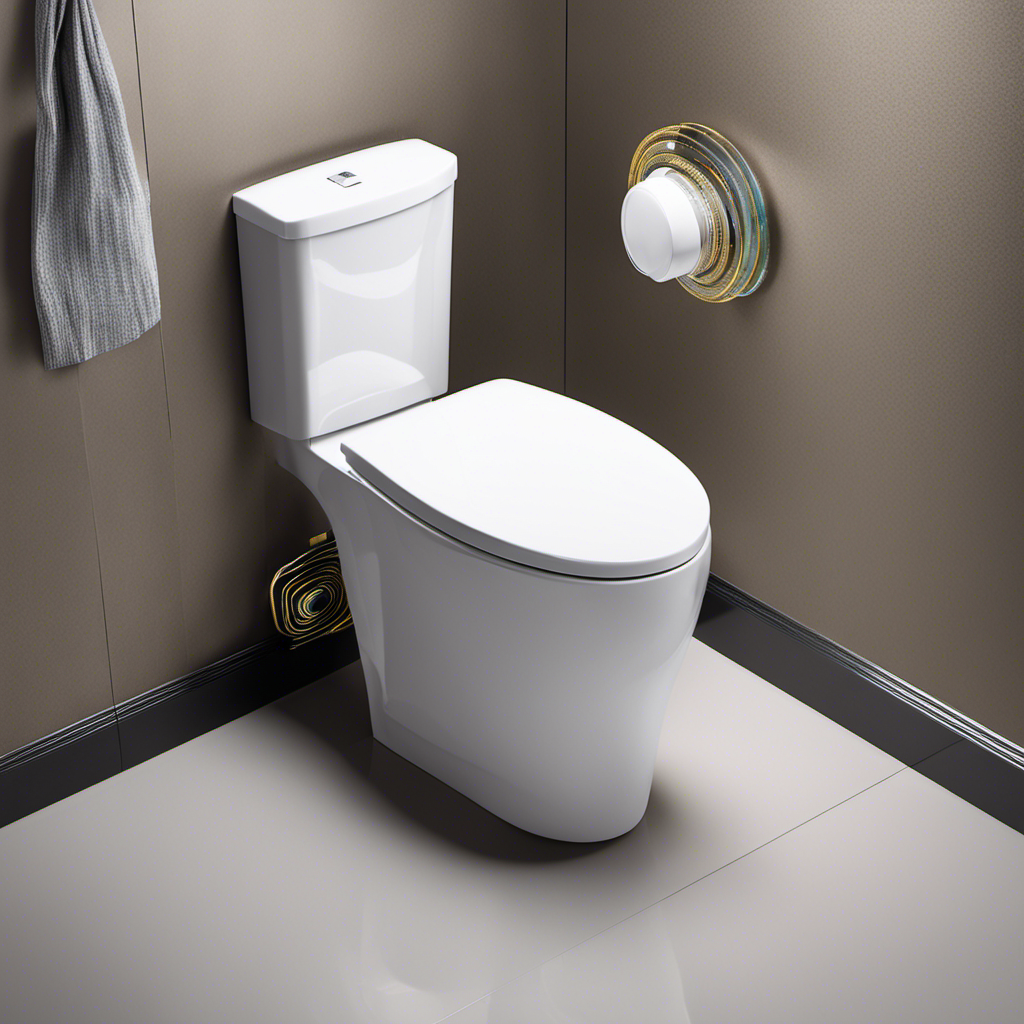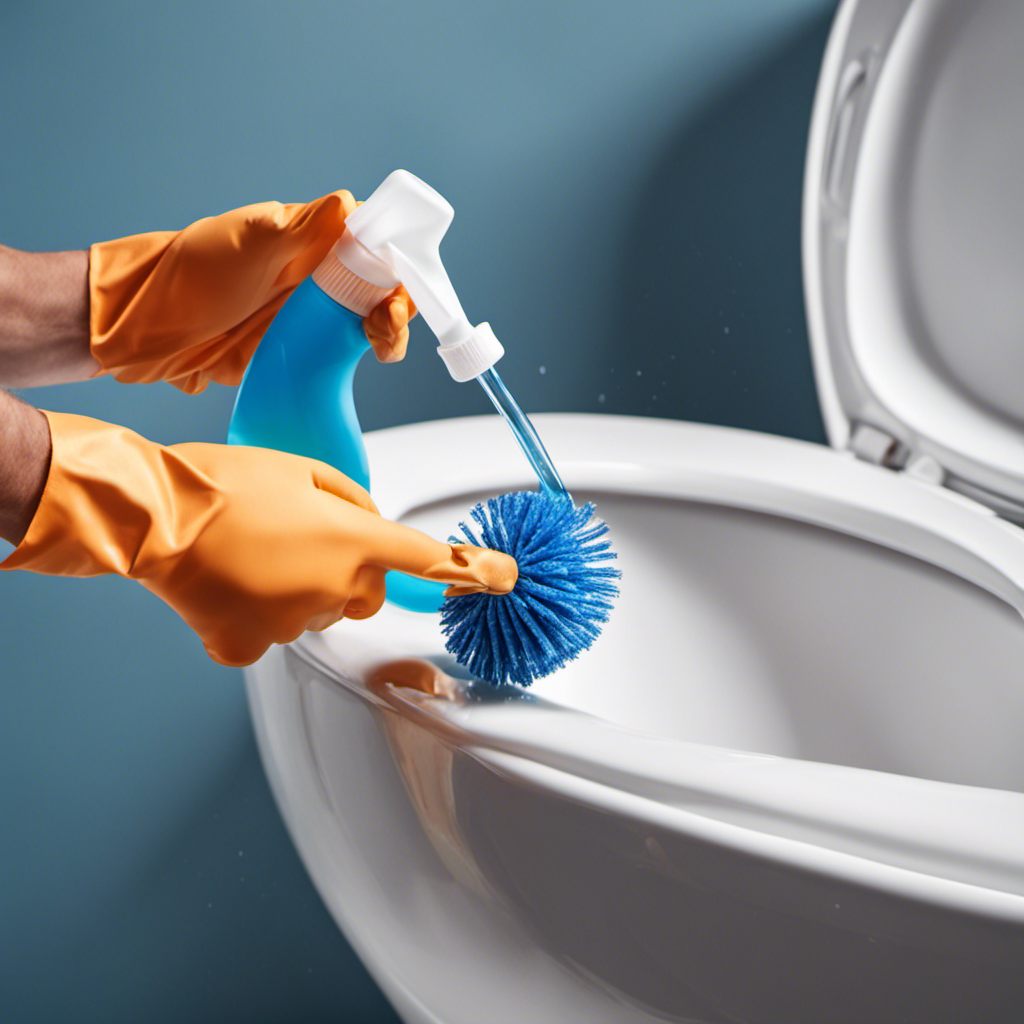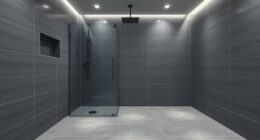I’ve always believed that a properly functioning toilet is a key indicator of a well-maintained home. It’s one of those little things that we often take for granted until it stops working.
But fear not, because in this article, I’m going to share with you my expertise on how to make your toilet flush like a champ. From understanding the flush mechanism to troubleshooting common issues, I’ve got you covered.
So let’s dive in and ensure your toilet is always ready for action.
Key Takeaways
- The main parts of a toilet flush mechanism are the flush valve, fill valve, and the lever or button.
- Common problems with the flush mechanism include a weak flush, continuous running toilet, or a toilet that won’t flush.
- Adjusting or replacing the flush handle can solve the issue of a faulty flush valve.
- Regular maintenance is essential for optimal performance, including checking for leaks, ensuring the flush handle is properly connected, inspecting the flapper valve, and adjusting the water level in the tank.
Understanding the Toilet Flush Mechanism
To understand how the toilet flush mechanism works, it’s important to know the different components involved.
The main parts of a toilet flush mechanism include the flush valve, fill valve, and the lever or button that activates the flush.
The flush valve is responsible for releasing water from the tank into the bowl to create the flushing action.
The fill valve is responsible for refilling the tank with water after a flush.
If you’re experiencing issues with your toilet flush mechanism, troubleshooting and repair may be necessary.
Common problems include a weak flush, a continuous running toilet, or a toilet that won’t flush at all.
Checking for Common Toilet Flush Issues
Check if there are any common issues with your toilet’s flushing. A malfunctioning toilet can be a frustrating problem, but often, the solution is simple. Start by examining the toilet flush handle. If it feels loose or doesn’t return to its normal position after flushing, it may need adjusting or replacing. Another common issue is a faulty toilet flush valve. This valve controls the release of water from the tank into the bowl. If it is worn out or damaged, it can cause the toilet to flush improperly or not at all. Replacing the flush valve is often an effective solution. By addressing these common issues, you can ensure a properly functioning toilet. Now let’s move on to adjusting the water level in the toilet tank.
| Common Issues | Possible Solutions |
|---|---|
| Loose flush handle | Adjust or replace |
| Faulty flush valve | Replace |
Now that we have checked for common issues with the toilet’s flushing mechanism, let’s move on to adjusting the water level in the toilet tank.
Adjusting the Water Level in the Toilet Tank
Now that we’ve addressed the common issues with the toilet’s flushing mechanism, let’s move on to adjusting the water level in the tank.
To ensure water conservation in toilets and maintain proper functionality, it is important to adjust the water level in the toilet tank. Here’s how you can do it yourself:
-
Locate the fill valve: This valve is usually on the left side of the tank and is connected to the water supply line. Turn it clockwise to lower the water level and counterclockwise to raise it.
-
Test and adjust: Flush the toilet and observe the water level. If it is too high, turn the valve clockwise until the desired level is reached. If it is too low, turn the valve counterclockwise.
-
Use the water level mark: Many tanks have a mark indicating the optimal water level. Adjust the valve until the water reaches this mark.
-
Test and repeat: Flush the toilet a few times to ensure the water level remains consistent. Make further adjustments if necessary.
Clearing Clogs and Blockages in the Toilet Drain
If you’re experiencing a clog or blockage in your toilet drain, there are a few steps you can take to clear it. First, try using a plunger to create suction and dislodge the obstruction. Make sure to cover the drain completely and push and pull firmly to create pressure. If the plunger doesn’t work, you can try using a toilet auger or snake. This tool is designed to reach deeper into the drain and break up or retrieve the blockage. Another option is using a chemical drain cleaner, although this should be a last resort as it can be harsh on your plumbing. Remember to always follow the instructions carefully and use protective gloves and eyewear when handling chemicals. Here is a table summarizing the different methods and tools for clearing toilet blockages:
| Method | Tools Needed | Pros |
|---|---|---|
| Plunger | Plunger | Easy to use, inexpensive |
| Toilet Auger/Snake | Auger/Snake | Reaches deeper into the drain |
| Chemical Drain Cleaner | Drain Cleaner, gloves, eyewear | Quick results, minimal effort |
Choose the method and tool that best suits your needs and preferences, and remember to exercise caution when attempting to clear a toilet blockage.
Maintaining and Troubleshooting the Toilet Flush System
Regular maintenance is essential for ensuring optimal performance and troubleshooting issues with the toilet’s flush system. Here are four key steps to diagnose and fix common problems with the toilet flush:
-
Diagnosing Toilet Leaks: Start by checking for any visible leaks around the base of the toilet or the water supply line. If you notice water pooling or dampness, it could indicate a leak that needs to be addressed promptly.
-
Checking the Flush Handle: Sometimes, a faulty flush handle can prevent the toilet from flushing properly. Ensure that the handle is properly connected to the flush mechanism and not loose or broken. If necessary, tighten or replace the handle to restore its functionality.
-
Inspecting the Flapper Valve: The flapper valve is responsible for controlling the water flow during the flush. Check if it is properly sealing the flush valve opening. If it’s worn out or damaged, replace it to prevent water wastage and inefficient flushing.
-
Adjusting Water Level: The water level in the toilet tank should be adjusted to the proper level, usually marked on the overflow tube. If the water level is too low or too high, it can affect the flush performance. Adjust the float or fill valve to achieve the correct water level.
Frequently Asked Questions
How Can I Make My Toilet Flush Quieter?
To make a toilet flush quieter, you can try implementing noise reduction and soundproofing techniques. These methods can help minimize the loud noise that occurs when flushing, creating a more peaceful and serene bathroom experience.
Why Does My Toilet Sometimes Continue to Run After Flushing?
Sometimes, my toilet continues to run after flushing due to toilet tank maintenance issues. Troubleshooting flush problems requires technical knowledge and precision. Let me explain the steps to fix it.
Can I Use Any Type of Toilet Paper With My Toilet Flush Mechanism?
Yes, you can use any type of toilet paper with most toilet flush mechanisms. However, some alternative flush mechanisms may require specific types of toilet paper for optimal performance.
How Often Should I Clean the Toilet Tank to Prevent Clogs?
To prevent toilet clogs, it’s important to clean the toilet tank regularly. The frequency of toilet tank cleaning depends on factors such as usage and water quality. Proper maintenance can help ensure a smooth flush.
Is It Normal for My Toilet to Have a Slight Odor After Flushing?
It is not normal for a toilet to have a slight odor after flushing. This could be a sign of a problem with the toilet flush mechanism or a buildup of bacteria. Proper toilet flush maintenance and troubleshooting can help address this issue.
Conclusion
In conclusion, understanding how to make a toilet flush is essential in maintaining a properly functioning bathroom fixture. By checking for common issues, adjusting the water level, clearing clogs, and regularly maintaining the flush system, you can ensure a smooth and efficient flush every time.
Did you know that a leaking toilet can waste up to 200 gallons of water per day? This staggering statistic emphasizes the importance of promptly fixing any toilet flush issues to conserve water and save on utility bills.










